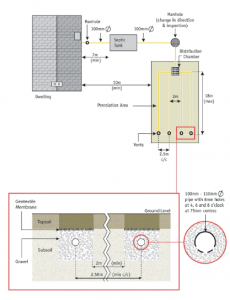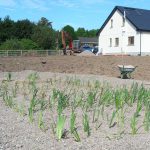Every house needs some way to deal with the waste water it generates from flushing the toilet, from showers, washing machines, and so on.
Images from The EPA Code of Practice: Wastewater Treatment and Disposal Systems Serving Single Houses (p.e.≤10) If you cannot connect to the mains wastewater network, then you will need an onsite waste water system and a percolation area for effluent disposal to ground. Even if you have a compost toilet (dry toilet system that does not require flushing) you still need a way to deal with greywater (dirty water from showers, machines, etc.). The word percolation is derived from Latin, Per Colare, literally to strain forward or through. For the purposes of effluent treatment and disposal, a percolation area allows effluent to pass through the permeable subsoil beneath the percolation trench, being filtered, or strained as it does so. A percolation test measures the rate at which water infiltrates down into the soil, and thus how suitable the soil will be in the longer term for effluent filtration and disposal. Also known as an infiltration area, a percolation area is the last part of the on-site wastewater treatment process. At its most basic it consists of a series of perforated pipes set in a gravel trench, in the ground, to provide filtration and treatment.
The septic tank effluent passes through it before exiting below, into the groundwater.
The unsaturated subsoil below the trench provides the filtration, so it is important that there is a sufficient depth above the bedrock or winter water table and that it has the correct percolation characteristics to function effectively.
Where the soil depth is insufficient, secondary treatment or tertiary treatment may be needed to ensure that the groundwater is protected from pollution.
Although the premise is the same, “percolation area” is the term used for septic tank effluent treatment and disposal; “soil polishing filter” is the term for secondary treated effluent disposal and “distribution area” the term used for tertiary treated effluent disposal.
A full overview of wastewater systems in Ireland is available here.
Also known as an infiltration area, a percolation area is the last part of the on-site wastewater treatment process. At its most basic it consists of a series of perforated pipes set in a gravel trench, in the ground, to provide filtration and treatment.
The septic tank effluent passes through it before exiting below, into the groundwater.
The unsaturated subsoil below the trench provides the filtration, so it is important that there is a sufficient depth above the bedrock or winter water table and that it has the correct percolation characteristics to function effectively.
Where the soil depth is insufficient, secondary treatment or tertiary treatment may be needed to ensure that the groundwater is protected from pollution.
Although the premise is the same, “percolation area” is the term used for septic tank effluent treatment and disposal; “soil polishing filter” is the term for secondary treated effluent disposal and “distribution area” the term used for tertiary treated effluent disposal.
A full overview of wastewater systems in Ireland is available here. [adrotate group="4"]
[adrotate group="3"]




